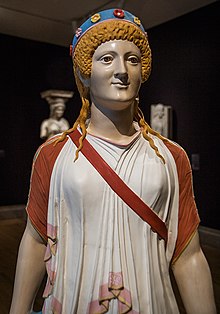'Gods In Color- Golden Edition': New Light On Ancient Classical Statues, Frankfurt Exhibit [View all]
Last edited Mon Feb 3, 2020, 09:06 PM - Edit history (2)
'Gods in Color': Shining new light on ancient statues. DW/Deutsche Welle, Feb. 3, 2020. Excerpts: (~ Here's to color!).
The knowledge that ancient Greek and Roman statues were colorfully painted has largely been suppressed in recent centuries. An exhibition explores this shaded past and shows figures in their vibrant original hues.
We often think of ancient statues as the white stone figures that have long dominated museum collections. But in recent years, the public has been reawakened to the fact that many of these antiquities were once brightly colored. In the exhibition "Gods in Color - Golden Edition," which features over 100 painted sculptures in Frankfurt's Liebieghaus museum, visitors can witness the polychromatic transformation of ancient statues and experience their original, eye-opening bright hues.

- The myth of colorlessness: "This strange concept of colorless sculptures dates back to the Renaissance," said archaeologist Vinzenz Brinkmann, head of the Antiquities and Asia departments at the museum and the curator of the show. Since beginning his research in Athens 40 years ago, Brinkmann has been studying the colors of ancient sculptures and brings his specialist expertise to the exhibition. "At that time in Rome, there was a lot of construction happening and one sculpture after another was found. They no longer had any color."
So at first, no one knew any better, he explained to DW. At the same time, the simplicity of colorlessness fit with the popular ideology of the period. "The colorless sculptures were used as a visual representations of the Enlightenment," Brinkmann added. The lack of color made the figures lose their sensuality, said the archaeologist. "They were put, so to speak, on a pedestal." Even the finding of the Laocoön and His Sons statue in Rome in 1503, which showed traces of color, could not shift assumptions about ancient statues being white. "It was deliberately looked over," Brinkmann said.
But as the exhibition shows, colors were used diffusely in the ancient world, with the Greeks and Romans painting their sculptures, not only for decoration, but to elaborate the story of each work. Polychromy gave increased depth of cultural and artistic expression. - New findings — and a fascist backlash..But with the rise of fascism in the 20th century, the tide turned again. The colorful figures of antiquity did not fit in with the aesthetics of dictators Mussolini, Franco, Hitler or Stalin. They were simply too sensual, says Brinkmann...
https://www.dw.com/en/gods-in-color-shining-new-light-on-ancient-statues/a-52240659
* EXHIBIT CATALOG, https://buntegoetter.liebieghaus.de/en/
- Archer from the western pediment of the Temple of Aphaia on Aigina, reconstruction, color variant A, as exhibited in Athens, perhaps depicting the Trojan prince, Paris.

- The Greek goddess Artemis, color reconstruction of a first century AD statue found in Pompeii, an imitation of Greek statues of the sixth century BC, reconstructed using analysis of trace of color.
- More, https://en.wikipedia.org/wiki/Gods_in_Color
- Peplos Kore, alternative reconstructions.

-> The exhibition "Gods in Color" at the Liebieghaus Museum in Frankfurt features over 100 works in their original colors.

